Spontaneous human combustion is an unexplained phenomenon. The human body suddenly catches fire, turning to ash, with no apparent external source of ignition. The consequences range from simple burns, blisters on the skin, to complete cremation. Interestingly, this combustion typically does not cause any damage to the room or surrounding furniture.
Over the years, it is reported that more than 200 people worldwide have been incinerated without any obvious cause.
Early Recorded Cases of Spontaneous Human Combustion
The first reliable historical evidence of human spontaneous combustion appeared in 1673 when Frenchman Jonas Dupont published a book titled “The Flame of Human Combustion,” which compiled cases of spontaneous combustion and studies on the phenomenon.
Dupont was inspired to write this book after reading the account of the case of Nicole Miller. In this case, a man was acquitted because the court was convinced that his wife, Nicole, died from spontaneous combustion rather than murder.
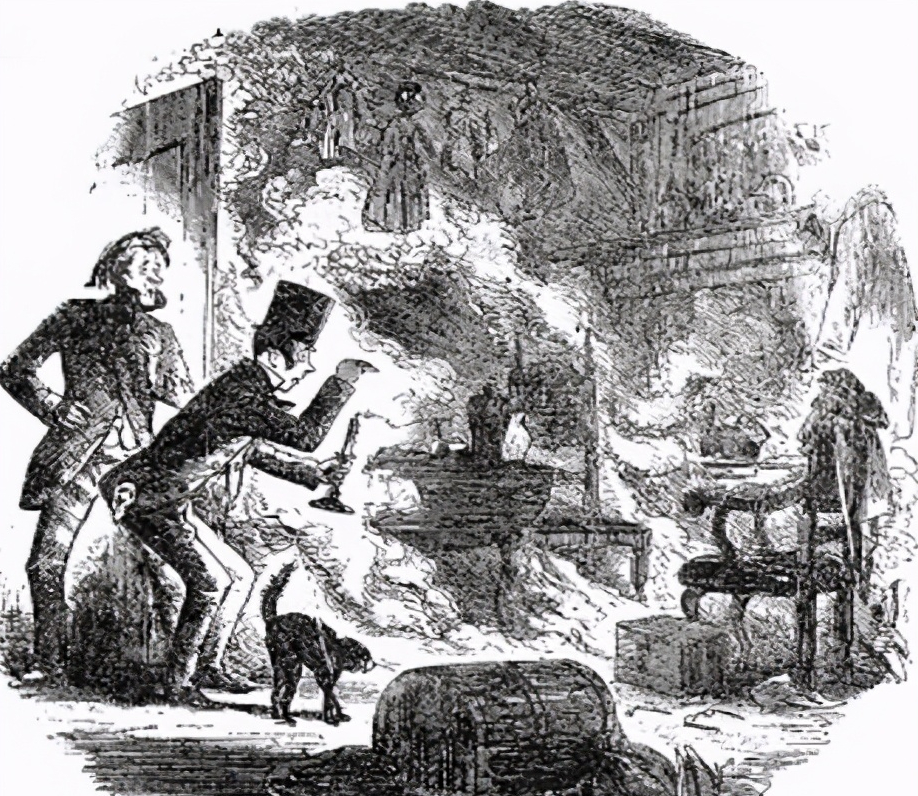
Another documented case of human spontaneous combustion occurred near Ottawa, Illinois, USA, in 1885. On the morning of Christmas Day that year, farmer Patrick Rooney and his wife were found dead in their home. Rooney was sitting in a chair, while the charred remains of his wife lay on the floor.
A large hole was burned into the floor, and the only remains of this 180-pound woman were a charred skull, two charred vertebrae, one foot, and a small pile of ashes. Strangely, the rest of the floor was not burned, the surrounding furniture was undamaged, and even the nearby tablecloth had only one corner torn.
Dr. Floyd Clemens, the coroner, testified in court that this was a typical case of spontaneous human combustion. The police also stated that Rooney’s cause of death was very clear: he was asphyxiated by the smoke from his wife’s burning body.
Among the many cases of spontaneous human combustion, the horrific death of an elderly American woman in 1951 is considered one of the most famous and thoroughly investigated.
The Disappearance of Mary Reeser

Mary Reeser was an ordinary resident of St. Petersburg, Florida, USA. In 1951, at the age of 67, she lived at 1200 Cherry Street in the city’s northeast. On the evening of July 1, 1951, around 9:00 PM, Mary’s only son, Richard Reeser Jr., came to visit his mother. According to Richard Jr.’s recollection, Mary was wearing silk pajamas, slippers, and a robe that night, and everything was in order in her apartment when he left.
The next morning, a postman arrived with a telegram for Mary Reeser. He knocked on the apartment door, but no one answered. He then notified Mary’s neighbor, landlady Pansy Carpenter. Mrs. Carpenter was certain that Mary had not left her apartment since the previous evening, and when she touched the doorknob, it felt unusually hot.

Mary Reeser’s rented apartment
Soon, the apartment door was broken down, and people rushed into a smoke-filled apartment. Despite some windows being half-open, everyone who entered Mary’s apartment immediately felt an extraordinary heat. They found no sign of Mary in her bedroom or other rooms, and finally, in the corner of the bathroom, they discovered a pile of hot black ash, next to it a wooden chair and a melted watch, the time on the watch frozen at 4:20 AM. This was evidently when everything happened.
At the time, people thought someone might have started a fire in the apartment, and one person began to sift through the steaming pile of ash. Suddenly, he screamed in terror – in the ashes, he found a woman’s left leg. Eventually, in the same pile of ashes, a few teeth, small fragments of vertebrae, and a skull were also found. But they were all strangely reduced in size, as if “shrunken.” Finally, the medical examiner confirmed that these were the remains of the unfortunate Mary Reeser.
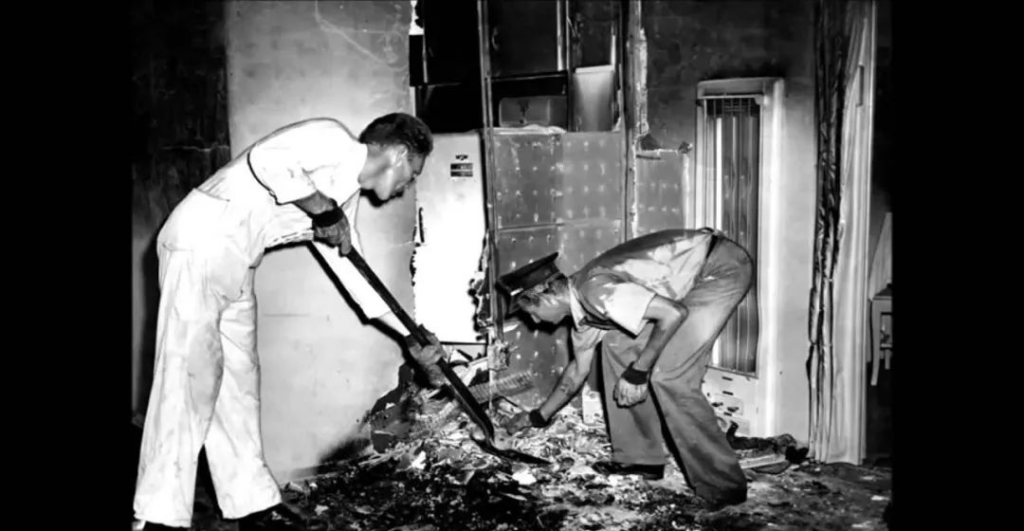
Investigators clearing the ashes
Later, the police carefully inspected the apartment, finding no signs of a break-in, no valuables missing, and no traces outside the house. No blood was found anywhere in the apartment. However, based on the scene investigation, the fire in the apartment had produced intense heat, with bare candle wicks towering over melted wax, smoke staining the ceiling, and electrical switches distorted by the heat.
Various Speculations
Experts immediately realized this was an unusual fire. They calculated that to reduce a human body, including the bones, almost entirely to ash, the temperature must have reached over 3000 degrees and sustained for several hours; otherwise, more bones would have remained. Given the location of the ashes, if such high temperatures were indeed present, not only would this apartment have been destroyed, but the fire would have spread to the entire building.
However, the fact was that even neighbors next door did not notice anything unusual. A reader of The New York Times in 1951 suggested that Mary Reeser might have died from spontaneous combustion. Soon, the “Mary Reeser Spontaneous Combustion Mystery” in St. Petersburg became national headline news.
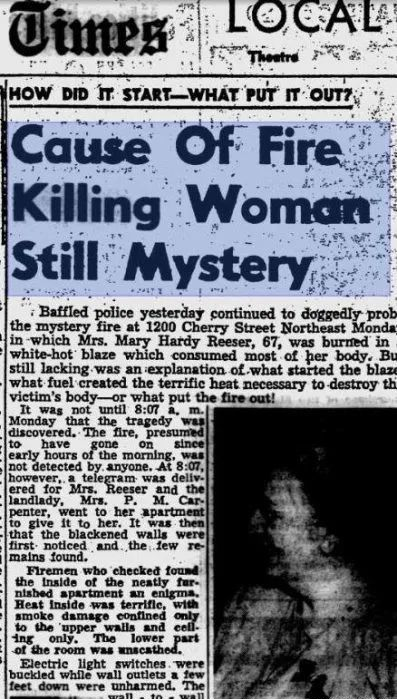
New York Times report in 1951
St. Petersburg Police Chief J.R. Richart received hundreds of theories from amateur detectives. Some claimed they had smelled a strange odor outside Reeser’s house, while others attributed the cause to everything from fabric on chair cushions to napalm, phosphorus bombs, and thermite. There were even claims of seeing a fireball flying through the window and striking Reeser.
As the investigation stalled, Richart wrote a letter to the Federal Bureau of Investigation for help. The police then sent boxes of evidence to the FBI lab in Washington, including “parts of the apartment’s carpet, smoke samples, debris from walls and floors, and fragments of the chair.” FBI agents spent three weeks investigating Reeser’s case.
Investigation Conclusion: Spontaneous Combustion Ruled Out?
On August 8, 1951, Richart issued a statement to the media, describing it as “the most unusual case I’ve seen in nearly 25 years as a police officer in St. Petersburg.” The statement said that FBI investigators found no evidence that lightning had struck Reeser’s apartment building, and all fuses in the apartment were intact. Investigators also failed to detect any substances that could have started the fire.
Richart wrote in the statement, “Common flammable liquids and catalysts, such as alcohol, gasoline, etc., could have been consumed in such a fire, leaving no trace afterward.” As for spontaneous combustion? That possibility was also ruled out. Investigators believed that Reeser might have been drowsy from sleeping pills, falling asleep while smoking in a chair. She was wearing acetate rayon pajamas, which are highly flammable, when she died. Thus, this could have been a fire caused by cigarette ash.
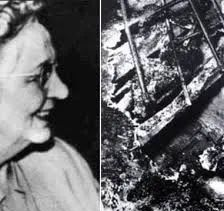
Moreover, Reeser weighed about 150 pounds, and her body fat could have caused the fire to smolder through the night, allowing hot air and smoke to rise to the top of the room. “Mary smoked heavily,” Mary’s daughter-in-law Ernestine Reeser told The St. Petersburg Times in 1991. “The cigarette fell onto her leg, and her fat was the fuel for her burning. The floor was concrete, the chair was isolated. There was nothing around her that could burn.”
Finally, the FBI proposed an official explanation: Mary accidentally set herself on fire with a cigarette. Investigators considered this accidental death the most credible theory.
Mysterious Combustion
However, Wilton M. Krogman, an anthropologist from the University of Pennsylvania, did not agree.
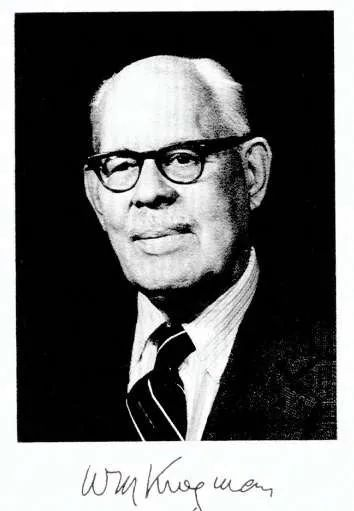
Wilton M. Krogman
“I find it hard to believe that a person’s body, once ignited, would completely consume itself. Burning, like a candlewick… I have never seen a body so completely reduced to ash by heat,” Krogman commented on Reeser’s case. “This goes against common experience, and I think it’s the most astonishing thing. I’ve never seen anything like it.”
Krogman believed that Reeser’s skull should have exploded rather than shrunk. According to The York Daily Record, Krogman said, “I can’t imagine such complete cremation without more fire in the apartment.”
Today, it’s been nearly 70 years since Reeser’s mysterious combustion. To this day, no one knows exactly what happened, and perhaps we may never get an answer. After the FBI investigation concluded, part of Reeser’s ashes were buried next to her husband’s grave in Pennsylvania, while the rest were buried in St. Petersburg.



















